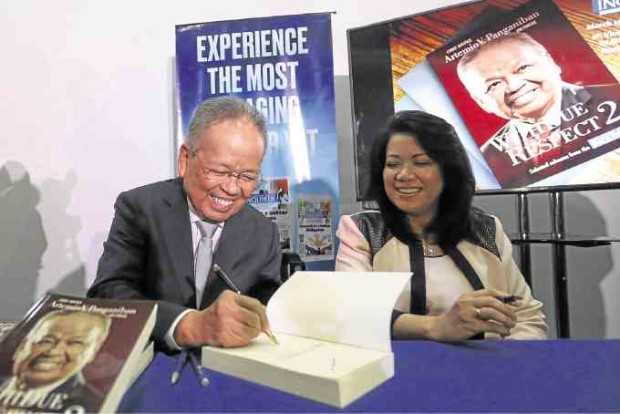Yes, CJ, there’s life after Supreme Court

Former Chief Justice Artemio Panganiban autographs a copy of his book, “With Due Respect 2” for current Chief Justice Maria Lourdes Sereno. —JOAN BONDOC
Is there life for former “gods of Padre Faura?”
Chief Justice Maria Lourdes Sereno has found the answer in one of her predecessors, retired Chief Justice Artemio Panganiban, who has unveiled his latest book, “With Due Respect 2,” a selection of his columns in the Inquirer with the same title.
Keynoting the book launch on Tuesday night, Sereno paid tribute to Panganiban’s zest in making public his views on a hodgepodge of issues concerning the Supreme Court and other legal matters through his weekly opinion column.
Over a decade after leaving the high court, the former chief justice, she said, has continued to help bridge the gap between the ordinary citizens and the justices, often regarded as “gods of Padre Faura” for their lofty stature as members of the country’s highest judicial body.
Instrumental
Article continues after this advertisementThe chief magistrate said Panganiban’s opinion pieces had been “very instrumental in explaining the work of the judiciary” to the public.
Article continues after this advertisement“Indeed, Chief Justice Panganiban’s reincarnation as columnist … is proof that there is life after retirement from the Supreme Court, including retirement from the position of Chief Justice,” Sereno told the gathering held at Rufino Campus of De La Salle University at Bonifacio Global City in Taguig City.
“Truly, one cannot expect a personality as vital as Chief Justice Panganiban to not have his voice heard anymore when he retired considering that that voice had eloquently and powerfully stood up for the liberty and prosperity of our people when he was sitting in the court,” she said.
Panganiban, who served as the tribunal’s 21st chief justice from December 2005 until his retirement a year later, was also instrumental in setting up the high court’s Public Information Office in 1999, Sereno noted.
Said the Chief Justice: “Through his column, (Panganiban), even after retirement from the court, continues to empower our people to engage and take part in the public discourse and debate by informing them about the national issues affecting them.”
Challenge
In his speech, Panganiban admitted that he reluctantly accepted the invitation of Inquirer chair Marixi Rufino Prieto to write a column despite having authored over 1,200 rulings and 11 books in his prolific 11-year career as member of the high tribunal.
After being used to writing lengthy decisions and legal opinions, it was a challenge for the former magistrate to contain his thoughts within the 4,100-character limit for Inquirer opinion columnists.
Since his first column was printed on Feb. 11, 2007, Panganiban had consistently put out an article every Sunday, producing a total of 525 articles within the 10-year period.
Second book
His second book, published six years after the first compilation of his writings was released, contained his opinion pieces from 2011 until June 2016.
“Looking back after writing 525 columns, I must say that I enjoyed and still enjoy writing for the Inquirer. Why? First, I am given complete freedom to dwell on any subject of my choice without interference from the owners and editors,” Panganiban said.
“Second, writing a column forces me to be updated on the latest news on what is going on in our country and the world, especially in the judiciary,” he said.